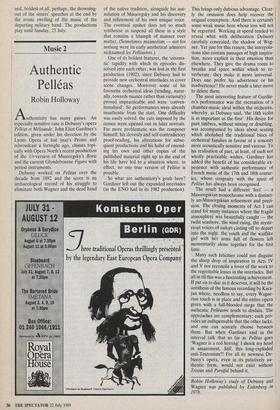Music 2
Authentic Pelleas
Robin Holloway
Authenticity has many guises. An especially sensitive case is Debussy's opera Pelleas et Melisande. John Eliot Gardiner's edition, given under his direction by the Lyons Opera at last year's Proms and rebroadcast a fortnight ago, chimes topi- cally with Opera North's recent production of the Ur-version of Mussorgsky's Boris and the current Glyndebourne Figaro with period instruments.
Debussy worked on Pelleas over the decade from 1892 and the score is an archaeological record of his struggle to eliminate both Wagner and the dead hand of the native tradition, alongside his assi- milation of Mussorgsky and his discovery and refinement of his own unique voice. The eventual upshot does not so much synthesise as suspend all these in a style that remains a triumph of manner over matter. (Sometimes mannerism — not for nothing were its early aesthetical admirers nicknamed les Pelleastres.) One of its boldest features, the 'cinema- tic' rapidity with which its episodes dis- solved into each other, was lost in the first production (1902), since Debussy had to provide new orchestral interludes to cover scene changes. Moreover some of his favourite orchestral ideas (tending, natur- ally, towards nuance rather than virtuosity) proved impracticable and were 'conven- tionalised'. So performances were already inauthentic from the start. One difficulty was easily solved: the cuts imposed by the censor were opened out in later revivals, Far more problematic was the composer himself: his slovenly and self-contradictory proof-reading, his alterations for subse- quent productions and his habit of emend- ing his own and other copies of the published material right up to the end of his life have led to a situation where, in effect, no one true version of Pelleas is possible.
So what are authenticity's goals here? Gardiner left out the expanded interludes (as the ENO had in its 1982 production).
This brings only dubious advantage. Clear- ly the omission does help recover the original conception. And there is certainly some weak music here whose loss will not be regretted. Working at speed tended to reveal what with deliberation Debussy carefully concealed, the shadow of Wag- ner. Yet just for this reason, the interpola- tions also contain passages of high inspira- tion, more explicit in their emotion than elsewhere. They give the drama room to breathe and ' space within which to re- verberate; they make it more Universal. Does one prefer his advertence or his inadvertence? He never made a later move to delete them.
The most interesting feature of Gardin- er's performarice was the recreation of a chamber-music ideal within the orchestra, whereby, as Debussy said, 'the 16th violin is as important as the first'. His desire for pure timbres, without mixing or doubling, was accompanied by ideas about seating which abolished the traditional blocs of orchestral families in favour of a sonority more acoustically sensitive and various. To his realisation of part, at least, of such not wholly practicable wishes, Gardiner has added the benefit of his considerable ex- perience with authentic performance of French music of the 17th and 18th centur- ies, whose congruity with the spirit of Pelleas has always been recognised.
The result had a different 'feel' — a Mussergskian monochrome with a distinct- ly un-Muss6rgskian refinement and preci- sion. The closing moments of Act I can stand for many instances where the fragile atmosphere was beautifully caught — the twilit seashore, the wind rising, the myste- rious voiees of• sailors casting off to depart into the night, the youth and' the waiflike girl' with her arms full of flowers left momentarily alone together for the first time.
Many such felicities could not disguise the sharp drop of inspiration in Acts IV and V nor reconcile a lover of the work to the regrettable losses in the interludes. But all in all this was a fascinating achievement. If put on to disc as it deserves, it will be the antithesis of the famous recording by Kara- jan where, needless to say, every Wagne- rian touch is in place and the entire opera given with a full-blooded surge that the authentic Pelleastre tends to disdain. The approaches are complementary; each pro- vides an indispensable that the other lacks, and one can scarcely choose between them. But when Gardiner said in the interval talk that so far as Pelleas goes 'Wagner is a red herring' I shook my head in amazement. Still, this long-exploded anti-Teutonism?! For all its newness De- bussy's opera, even in its putatively au- thentic form, would not exist without Tristan and Parsifal behind it.
Robin Holloway's study of Debussy and Wagner was published by Eulenberg in 1978.


















































 Previous page
Previous page